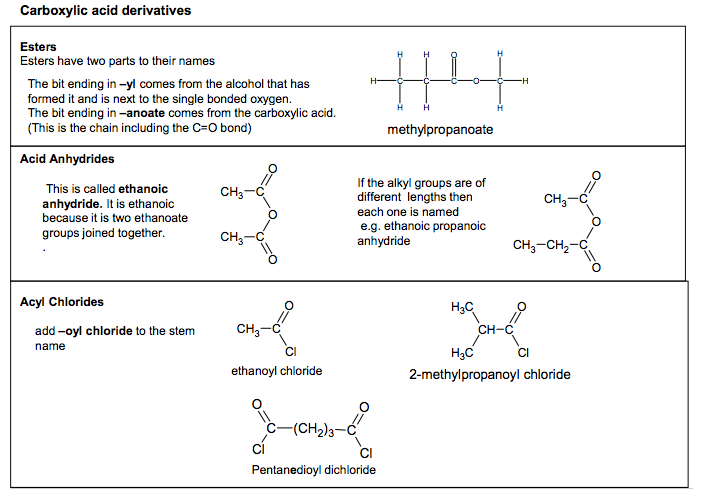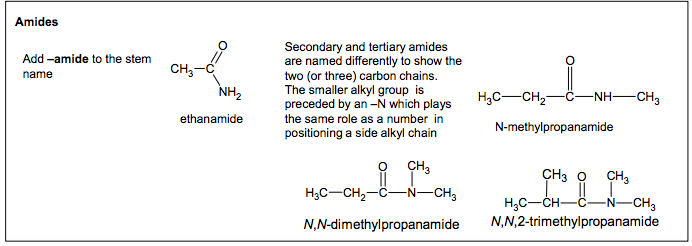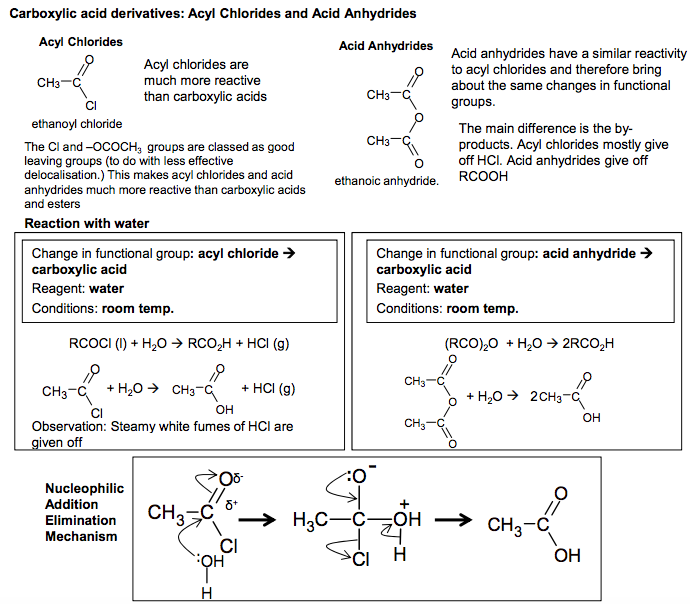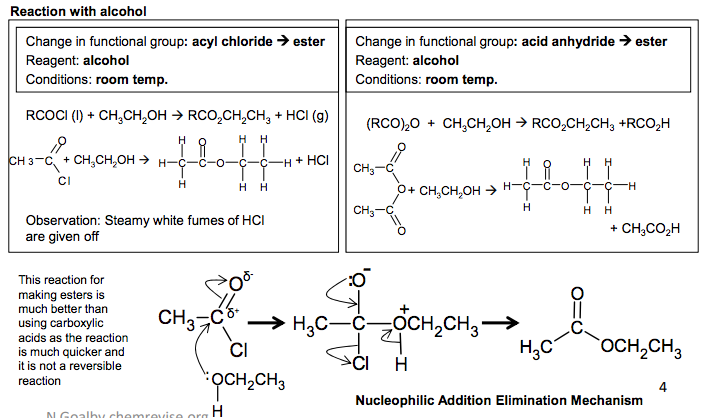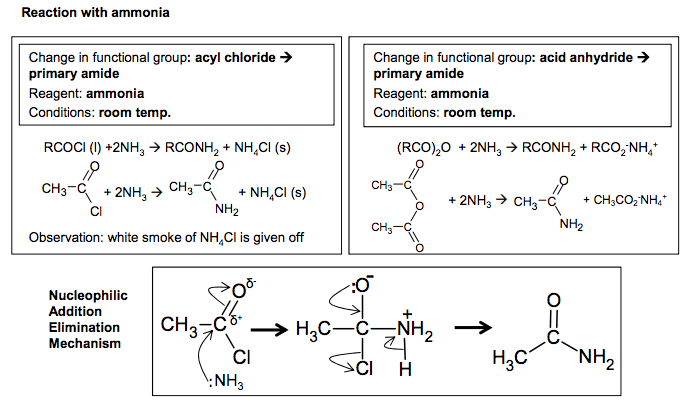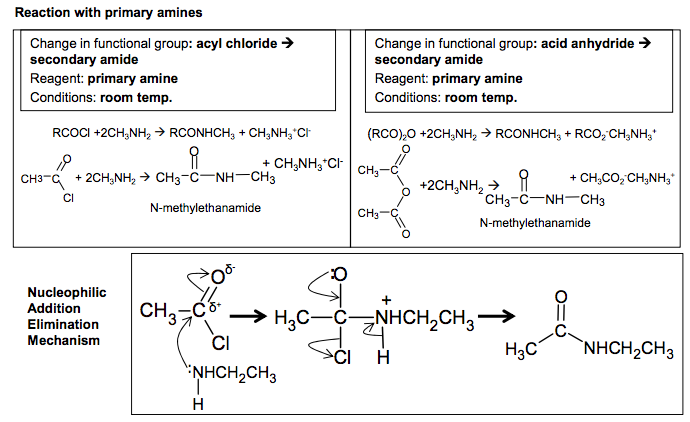Introduction
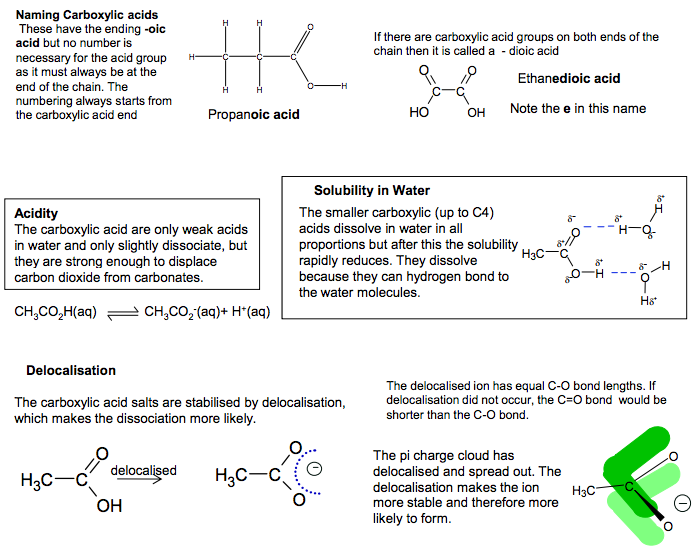


Naming Carboxylic acids These have the ending -oic acid but no number is necessary for the acid group as it must always be at the end of the chain. The numbering always starts from the carboxylic acid end C C O O H H C H H H H Propanoic acid If there are carboxylic acid groups on both ends of the chain then it is called a – dioic acid C C O OH O HO Ethanedioic acid Note the e in this name. Solubility in Water The smaller carboxylic (up to C4) acids dissolve in water in all proportions but after this the solubility rapidly reduces. They dissolve because they can hydrogen bond to the water molecules. H3C C O O H O H H O H H Acidity The carboxylic acid are only weak acids in water and only slightly dissociate, but they are strong enough to displace carbon dioxide from carbonates. CH3CO2H(aq) CH3CO2 -(aq)+ H+ (aq) Delocalisation The carboxylic acid salts are stabilised by delocalisation, which makes the dissociation more likely. delocalised H3C C O OH H3C C O O The delocalised ion has equal C-O bond lengths. If delocalisation did not occur, the C=O bond would be shorter than the C-O bond. H3C C O O The pi charge cloud has delocalised and spread out. The delocalisation makes the ion more stable and therefore more likely to form. Strength of carboxylic acids C C O OH H H Cl CH2 C O OH H3C CH2 C O O delocalised H3C delocalised Increasing chain length pushes electron density on to the COOion, making it more negative and less stable. This make the acid less strong. Alkyl groups electron releasing Chlorine electron withdrawing Electronegative chlorine atoms withdraw electron density from the COOion, making it less negative and more stable. This make the acid more strong. Propanoic acid less acidic than ethanoic acid chloroethanoic acid more acidic than ethanoic. Salt formation reactions of carboxylic acids Carboxylic acids can form salts with metals, alkalis and carbonates. acid + metal (Na) salt + hydrogen 2CH3CO2H + 2Na 2CH3CO2 -Na+ + H2 acid + alkali (NaOH) salt + water CH3CO2H + NaOH CH3CO2 -Na+ + H2O acid + carbonate (Na2CO3 ) salt + water + CO2 2CH3CO2H + Na2CO3 2CH3CO2 -Na+ + H2O + CO2 The effervescence caused by production of CO2 with carboxylic acids with solid Na2CO3 or aqueous NaHCO3 can be used as a functional group test for carboxylic acids. Oxidation of methanoic acid Carboxylic acids cannot be oxidised by using oxidising agents but methanoic acid is an exception as its structure has effectively an aldehyde group C O O H H C O O H + [O] H O It forms carbonic acid (H2 CO3 ) which can decompose to give CO2
/
~
~
~
/
3.3.9.1 Carboxylic acids and esters (A-level only)
The structures of:
• carboxylic acids
Carboxylic acids are weak acids but will liberate CO2 from carbonates.
Esterification and hydrolysis of esters
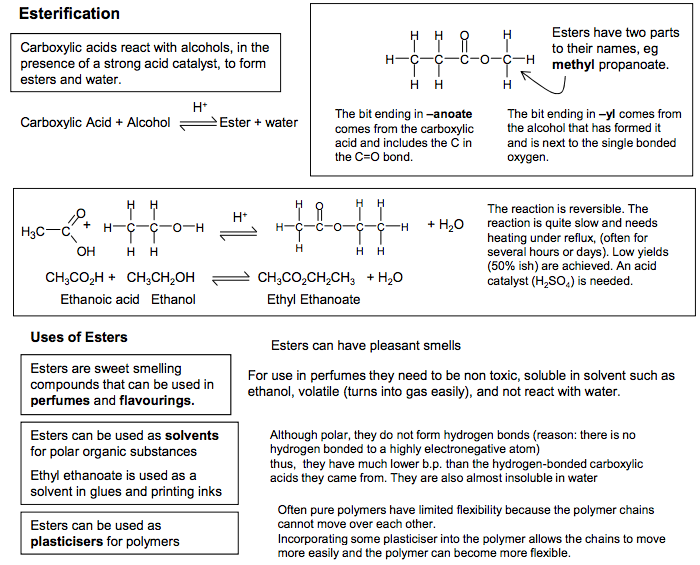

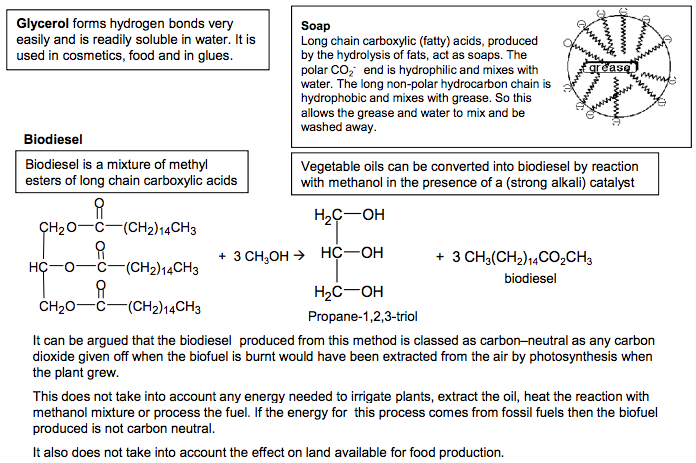
Esterification Carboxylic acids react with alcohols, in the presence of a strong acid catalyst, to form esters and water. C C C O O C H H H H H H H H Esters have two parts to their names, eg methyl propanoate. The bit ending in –yl comes from the alcohol that has formed it and is next to the single bonded oxygen. The bit ending in –anoate comes from the carboxylic acid and includes the C in the C=O bond. Carboxylic Acid + Alcohol Ester + water H+ The reaction is reversible. The reaction is quite slow and needs heating under reflux, (often for several hours or days). Low yields (50% ish) are achieved. An acid catalyst (H2SO4 ) is needed. + + H2O H3C C O OH C C O O C C H H H H H H H H H+ C O H H H C H H H CH3CO2H + CH3CH2OH CH3CO2CH2CH3 + H2O Ethanoic acid Ethanol Ethyl Ethanoate Uses of Esters Esters can have pleasant smells Esters are sweet smelling compounds that can be used in perfumes and flavourings. For use in perfumes they need to be non toxic, soluble in solvent such as ethanol, volatile (turns into gas easily), and not react with water. Esters can be used as solvents for polar organic substances Ethyl ethanoate is used as a solvent in glues and printing inks Although polar, they do not form hydrogen bonds (reason: there is no hydrogen bonded to a highly electronegative atom) thus, they have much lower b.p. than the hydrogen-bonded carboxylic acids they came from. They are also almost insoluble in water Esters can be used as plasticisers for polymers Often pure polymers have limited flexibility because the polymer chains cannot move over each other. Incorporating some plasticiser into the polymer allows the chains to move more easily and the polymer can become more flexible. Hydrolysis of esters Esters can be hydrolysed and split up by either heating with acid or with sodium hydroxide. i) with acid reagents: dilute acid (HCl) conditions: heat under reflux This reaction is the reverse reaction of ester formation. When an ester is hydrolysed a carboxylic acid and an alcohol are formed. CH3CH2CO2CH2CH3 + H2O CH3CH2CO2H + CH3CH2OH ethyl propanoate H+ This reaction is reversible and does not give a good yield of the products. ii) with sodium hydroxide reagents: dilute sodium hydroxide conditions: heat under reflux CH3CH2CO2CH3 + NaOH CH3CH2CO2 – Na+ + CH3OH methyl propanoate sodium propanoate methanol The carboxylic acid salt product is the anion of the carboxylic acid. The anion is resistant to attack by weak nucleophiles such as alcohols, so the reaction is not reversible. This reaction goes to completion. Fats and oils are ESTERS of glycerol and long chain carboxylic acids (fatty acids) Fats and soaps Vegetable oils and animal fats can be hydrolysed to give soap, glycerol and long chain carboxylic (fatty) acids H2C HC H2C OH OH OH + 3 KOH + 3 CH3 (CH2 )16 CO2 –K+ Propane-1,2,3-triol long chain carboxylic (fatty) acids Soap Long chain carboxylic (fatty) acids, produced by the hydrolysis of fats, act as soaps. The polar CO2 – end is hydrophilic and mixes with water. The long non-polar hydrocarbon chain is hydrophobic and mixes with grease. So this allows the grease and water to mix and be washed away. Glycerol forms hydrogen bonds very easily and is readily soluble in water. It is used in cosmetics, food and in glues. Vegetable oils can be converted into biodiesel by reaction with methanol in the presence of a (strong alkali) catalyst Biodiesel Biodiesel is a mixture of methyl esters of long chain carboxylic acids CH2 HC CH2 O O O C C C O O O (CH2)14CH3 (CH2)14CH3 (CH2)14CH3 + 3 CH3OH H2C HC H2C OH OH OH + 3 CH3 (CH2 )14CO2CH3 It can be argued that the biodiesel produced from this method is classed as carbon–neutral as any carbon dioxide given off when the biofuel is burnt would have been extracted from the air by photosynthesis when the plant grew. This does not take into account any energy needed to irrigate plants, extract the oil, heat the reaction with methanol mixture or process the fuel. If the energy for this process comes from fossil fuels then the biofuel produced is not carbon neutral. It also does not take into account the effect on land available for food production.
/
~
~
~
/
3.3.9.1 Carboxylic acids and esters (A-level only)
The structures of:
• esters
Carboxylic acids and alcohols react, in the presence of an acid catalyst, to give esters.
Common uses of esters (eg in solvents, plasticisers, perfumes and food flavourings).
Vegetable oils and animal fats are esters of propane-1,2,3-triol (glycerol).
Esters can be hydrolysed in acid or alkaline conditions to form alcohols and carboxylic acids or salts of carboxylic acids.
Vegetable oils and animal fats can be hydrolysed in alkaline conditions to give soap (salts of long-chain carboxylic acids) and glycerol.
Biodiesel is a mixture of methyl esters of long-chain carboxylic acids.
Biodiesel is produced by reacting vegetable oils with methanol in the presence of a catalyst.
Carboxylic acid derivatives
/
~
~
~
/
3.3.9.2 Acylation (A-level only)
The structures of:
• acid anhydrides
• acyl chlorides
• amides.
The nucleophilic addition–elimination reactions of water, alcohols, ammonia and primary amines with acyl chlorides and acid anhydrides.
The industrial advantages of ethanoic anhydride over ethanoyl chloride in the manufacture of the drug aspirin.
Students should be able to outline the mechanism of nucleophilic addition–elimination reactions of acyl chlorides with water, alcohols, ammonia and primary amines.
Required practical 10: Preparing organic solid
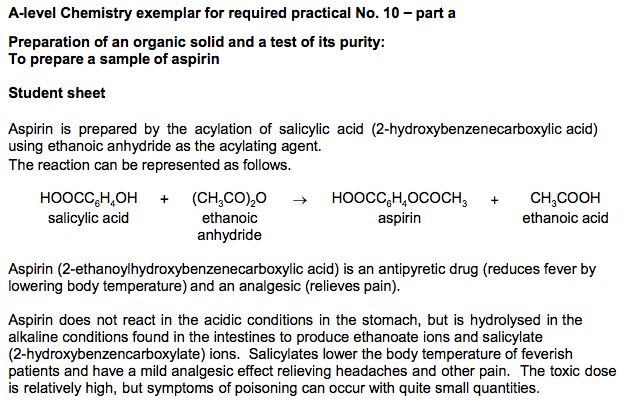
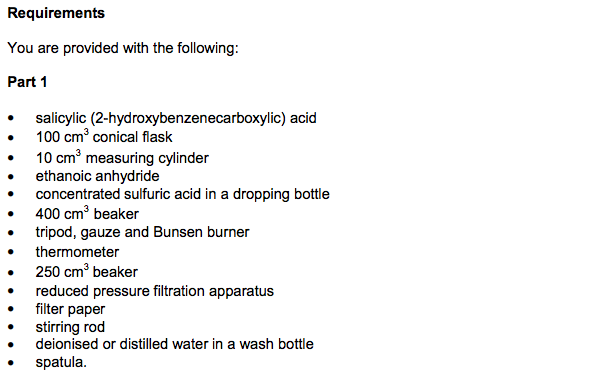
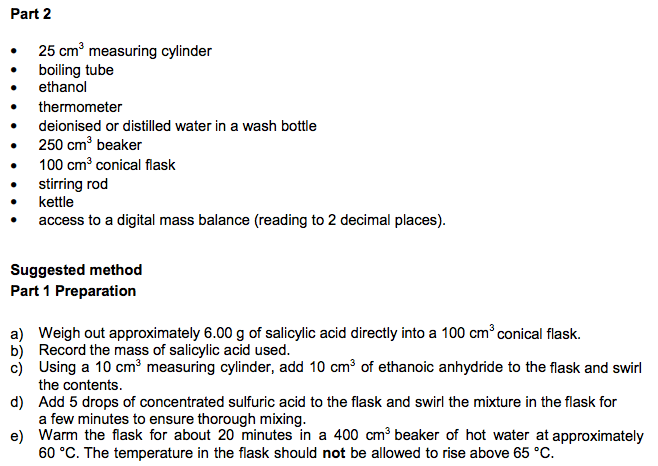
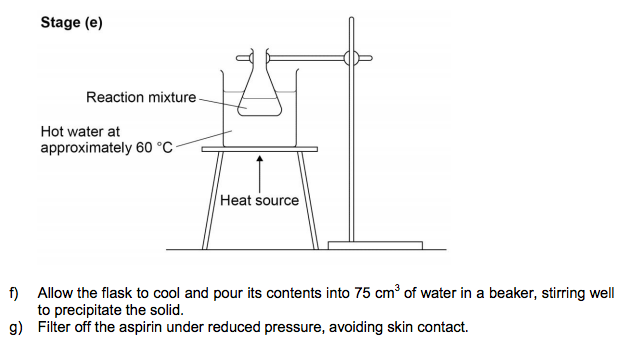
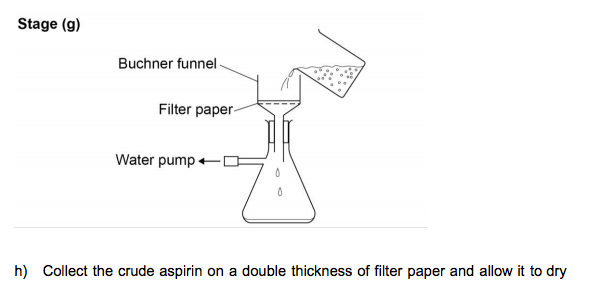
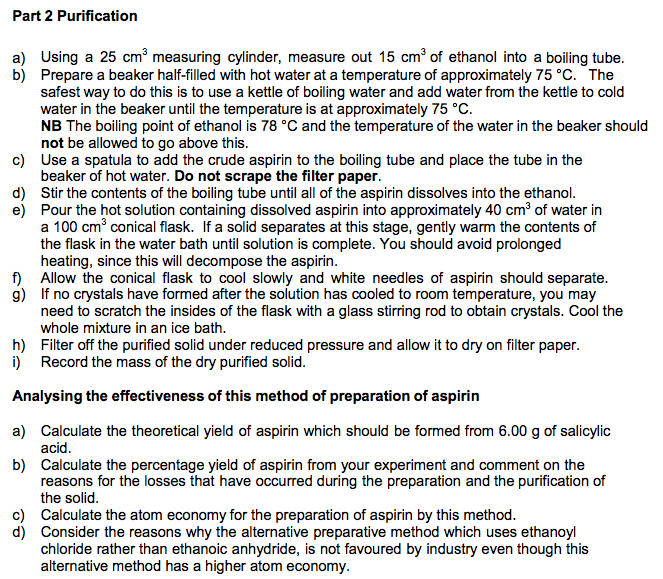



A-level Chemistry exemplar for required practical No. 10 – part a Preparation of an organic solid and a test of its purity: To prepare a sample of aspirin Student sheet Aspirin is prepared by the acylation of salicylic acid (2-hydroxybenzenecarboxylic acid) using ethanoic anhydride as the acylating agent. The reaction can be represented as follows. HOOCC6H4OH + (CH3CO)2O HOOCC6H4OCOCH3 + CH3COOH salicylic acid ethanoic anhydride aspirin ethanoic acid Aspirin (2-ethanoylhydroxybenzenecarboxylic acid) is an antipyretic drug (reduces fever by lowering body temperature) and an analgesic (relieves pain). Aspirin does not react in the acidic conditions in the stomach, but is hydrolysed in the alkaline conditions found in the intestines to produce ethanoate ions and salicylate (2-hydroxybenzencarboxylate) ions. Salicylates lower the body temperature of feverish patients and have a mild analgesic effect relieving headaches and other pain. The toxic dose is relatively high, but symptoms of poisoning can occur with quite small quantities. Requirements You are provided with the following: Part 1 salicylic (2-hydroxybenzenecarboxylic) acid 100 cm3 conical flask 10 cm3 measuring cylinder ethanoic anhydride concentrated sulfuric acid in a dropping bottle 400 cm3 beaker tripod, gauze and Bunsen burner thermometer 250 cm3 beaker reduced pressure filtration apparatus filter paper stirring rod deionised or distilled water in a wash bottle spatula. Part 2 25 cm3 measuring cylinder boiling tube ethanol thermometer deionised or distilled water in a wash bottle 250 cm3 beaker 100 cm3 conical flask stirring rod kettle access to a digital mass balance (reading to 2 decimal places). Suggested method Part 1 Preparation a) Weigh out approximately 6.00 g of salicylic acid directly into a 100 cm 3 conical flask. b) Record the mass of salicylic acid used. c) Using a 10 cm 3 measuring cylinder, add 10 cm 3 of ethanoic anhydride to the flask and swirl the contents. d) Add 5 drops of concentrated sulfuric acid to the flask and swirl the mixture in the flask for a few minutes to ensure thorough mixing. e) Warm the flask for about 20 minutes in a 400 cm 3 beaker of hot water at approximately 60 °C. The temperature in the flask should not be allowed to rise above 65 °C. f) Allow the flask to cool and pour its contents into 75 cm 3 of water in a beaker, stirring well to precipitate the solid. g) Filter off the aspirin under reduced pressure, avoiding skin contact.h) Collect the crude aspirin on a double thickness of filter paper and allow it to dry Part 2 Purification a) Using a 25 cm3 measuring cylinder, measure out 15 cm3 of ethanol into a boiling tube. b) Prepare a beaker half-filled with hot water at a temperature of approximately 75 °C. The safest way to do this is to use a kettle of boiling water and add water from the kettle to cold water in the beaker until the temperature is at approximately 75 °C. NB The boiling point of ethanol is 78 °C and the temperature of the water in the beaker should not be allowed to go above this. c) Use a spatula to add the crude aspirin to the boiling tube and place the tube in the beaker of hot water. Do not scrape the filter paper. d) Stir the contents of the boiling tube until all of the aspirin dissolves into the ethanol. e) Pour the hot solution containing dissolved aspirin into approximately 40 cm 3 of water in a 100 cm3 conical flask. If a solid separates at this stage, gently warm the contents of the flask in the water bath until solution is complete. You should avoid prolonged heating, since this will decompose the aspirin. f) Allow the conical flask to cool slowly and white needles of aspirin should separate. g) If no crystals have formed after the solution has cooled to room temperature, you may need to scratch the insides of the flask with a glass stirring rod to obtain crystals. Cool the whole mixture in an ice bath. h) Filter off the purified solid under reduced pressure and allow it to dry on filter paper. i) Record the mass of the dry purified solid. Analysing the effectiveness of this method of preparation of aspirin a) Calculate the theoretical yield of aspirin which should be formed from 6.00 g of salicylic acid. b) Calculate the percentage yield of aspirin from your experiment and comment on the reasons for the losses that have occurred during the preparation and the purification of the solid. c) Calculate the atom economy for the preparation of aspirin by this method. d) Consider the reasons why the alternative preparative method which uses ethanoyl chloride rather than ethanoic anhydride, is not favoured by industry even though this alternative method has a higher atom economy. To test the purity of an organic solid by measuring its melting point The purity of an organic solid can be determined in part by measuring its melting point and comparing the value with the known Data Book value of the melting point for that compound. A pure dry solid will melt at a precise temperature whereas an impure solid will melt over a range of temperatures which are lower than the melting point of the pure solid. Melting point apparatus varies in type from the most simple using an oil bath to the more sophisticated electrothermal devices. In every case, the same general principle applies that the heating of a small quantity of the solid in a thin-walled melting point tube should be undertaken slowly and with care. When melting occurs, the solid should collapse into a liquid without any change in temperature and the way in which this occurs can give a clue to the purity of the solid. Repeat measurements should be taken with further samples of the organic solid to verify the reliability of the value obtained. The method will not work if the solid decomposes on heating. Requirements You are provided with the following: pure benzenecarboxylic acid other pure organic solids as desired by the centre thermometer (0 °C to 250 °C range) melting point apparatus to include either: an electrothermal melting point apparatus or oil bath (Thiele tube or small beaker halffilled with mineral oil) tripod, gauze and Bunsen burner rubber ring to attach melting point tube to thermometer (if needed) melting point tubes watch glass spatula.Suggested method a) Powder a sample of the organic solid by crushing it gently with a spatula onto the surface of a filter paper. b) Fill three melting point tubes with the organic solid to a depth of approximately 0.5 cm. c) Set up the melting point apparatus provided and mount one of the melting point tubes ready for taking a measurement. d) Heat the apparatus gently and observe the temperature at which the solid collapses into a liquid. The melting point will be in the range 100 °C to 200 °C. e) Allow the melting point apparatus to cool and repeat the measurement of the melting point of the solid with the other two samples. If the first reading is taken as an approximate value, then the subsequent heating of the other two samples can be done much more slowly as this approximate value is approached. f) On the basis of the three measurements that you have taken, record the melting point of the organic solid. g) Ask your teacher for the Data Book value of the melting point for the solid that you have tested and compare this value with your own.
/
~
~
~
/
3.3.9.2 Acylation (A-level only)
Required practical 10
Preparation of:
• a pure organic solid and test of its purity
Required practical 10: Preparing organic liquid
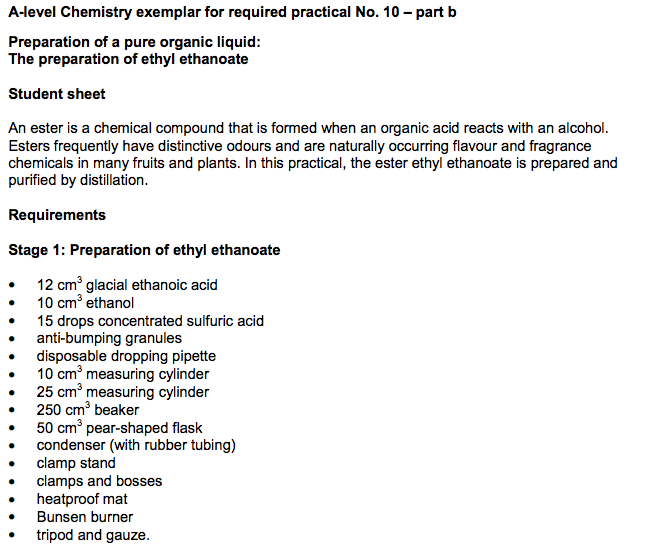

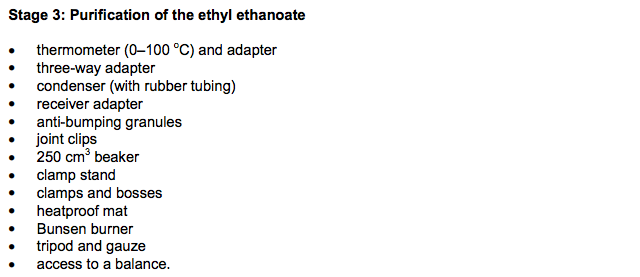

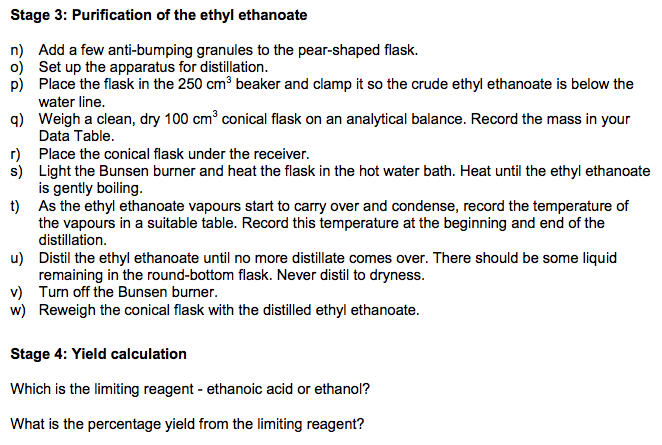
A-level Chemistry exemplar for required practical No. 10 – part b Preparation of a pure organic liquid: The preparation of ethyl ethanoate Student sheet An ester is a chemical compound that is formed when an organic acid reacts with an alcohol. Esters frequently have distinctive odours and are naturally occurring flavour and fragrance chemicals in many fruits and plants. In this practical, the ester ethyl ethanoate is prepared and purified by distillation. Requirements Stage 1: Preparation of ethyl ethanoate 12 cm3 glacial ethanoic acid 10 cm3 ethanol 15 drops concentrated sulfuric acid anti-bumping granules disposable dropping pipette 10 cm3 measuring cylinder 25 cm3 measuring cylinder 250 cm3 beaker 50 cm3 pear-shaped flask condenser (with rubber tubing) clamp stand clamps and bosses heatproof mat Bunsen burner tripod and gauze. Stage 2: Isolation of ethyl ethanoate 4.5 g sodium carbonate 15 cm3 distilled or deionised water 100 cm3 beaker 50 cm3 beaker separating funnel and stopper anhydrous sodium sulfate boiling tube 50 cm3 pear-shaped flask. Stage 3: Purification of the ethyl ethanoate thermometer (0–100 oC) and adapter three-way adapter condenser (with rubber tubing) receiver adapter anti-bumping granules joint clips 250 cm3 beaker clamp stand clamps and bosses heatproof mat Bunsen burner tripod and gauze access to a balance. Suggested method Stage 1: Preparation of ethyl ethanoate a) Put a few anti-bumping granules in a 50 cm3 pear-shaped flask. b) In a fume-cupboard, add 10 cm3 ethanol, 12 cm3 glacial ethanoic acid and 15 drops of concentrated sulfuric acid to the flask. c) Place a 250 cm3 beaker containing some water on a tripod and gauze over a Bunsen burner. d) Clamp the pear-shaped flask in the beaker of water so that the reaction mixture is below the water line. e) Add a condenser so that it is set up for heating with reflux. Clamp the condenser. Do not insert a stopper. f) Light the Bunsen burner to heat the hot water bath. Raise the temperature of the hot water until the mixture in the flask is gently boiling. Continue the gentle boil of the reaction mixture for about 15 minutes. Turn off the Bunsen burner and cool the mixture by removing the hot water bath. Stage 2: Isolation of ethyl ethanoate g) Prepare a saturated solution of sodium carbonate by combining 4.5 g of sodium carbonate with 15 cm3 of distilled water in a 100 cm3 beaker. h) In a fume cupboard, transfer the reaction mixture from the pear-shaped flask to the beaker and stir. i) Transfer the mixture to a separating funnel. Stopper it and turn it upside down gently and then open the stopcock to vent the system. Invert at least 15–20 times, opening the stopcock each time. j) Allow the two layers to separate. Ethyl ethanoate is less dense than water, therefore the top layer is ethyl ethanoate. k) Remove the stopper, open the stopcock and slowly drain off the waste aqueous layer into a 50 cm3 waste beaker, then close the stopcock. l) Transfer the remaining ethyl ethanoate into a dry boiling tube containing about 1 g of anhydrous sodium sulfate. Agitate the tube so that any water is absorbed into the anhydrous solid. m) Decant the ethyl ethanoate into a clean, dry 50 cm3 pear-shaped flask.Stage 3: Purification of the ethyl ethanoate n) Add a few anti-bumping granules to the pear-shaped flask. o) Set up the apparatus for distillation. p) Place the flask in the 250 cm3 beaker and clamp it so the crude ethyl ethanoate is below the water line. q) Weigh a clean, dry 100 cm3 conical flask on an analytical balance. Record the mass in your Data Table. r) Place the conical flask under the receiver. s) Light the Bunsen burner and heat the flask in the hot water bath. Heat until the ethyl ethanoate is gently boiling. t) As the ethyl ethanoate vapours start to carry over and condense, record the temperature of the vapours in a suitable table. Record this temperature at the beginning and end of the distillation. u) Distil the ethyl ethanoate until no more distillate comes over. There should be some liquid remaining in the round-bottom flask. Never distil to dryness. v) Turn off the Bunsen burner. w) Reweigh the conical flask with the distilled ethyl ethanoate. Stage 4: Yield calculation Which is the limiting reagent – ethanoic acid or ethanol? What is the percentage yield from the limiting reagent?
/
~
~
~
/
3.3.9.2 Acylation (A-level only)
Required practical 10
Preparation of:
• a pure organic liquid.
Credits: Neil Goalby






